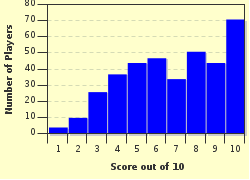Quiz Answer Key and Fun Facts
1. What is the order of sharps (#)?
2. Which of these tempos is the fastest?
3. What do two half notes equal?
4. If a note is above the third line on the staff, which way should the stem go?
5. How many spaces are there between the lines on a single staff?
6. Where does the time signature appear?
7. If there's a dot after a note, what happens?
8. Are two notes that sound the same but have different note names called semitone notes?
9. In written music, the flat sign comes before the note it relates to in the staff.
10. How many music letters are there in music?
Source: Author
hagga
This quiz was reviewed by FunTrivia editor
NatalieW before going online.
Any errors found in FunTrivia content are routinely corrected through our feedback system.

